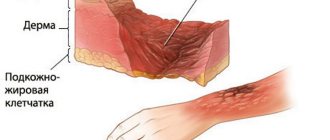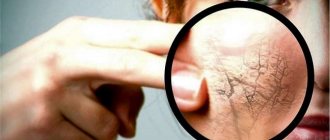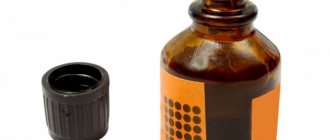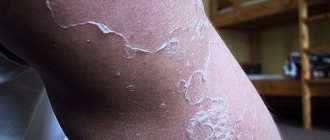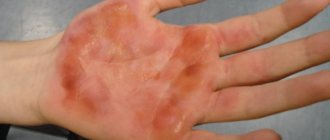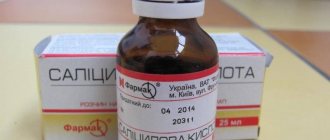A burn is an acute injury to the skin and tissue underneath. Injury occurs from radiation, electric shock, chemicals, or temperature exposure. Burns from boiling water most often occur at home. If this happens, you need to act immediately, since the depth and area of the damage, as well as the recovery period, depend on this.
For minor damage, first aid for burns with boiling water can be provided at home, but if you receive a 3rd or 4th degree burn, you should urgently call a doctor. Opening blisters is prohibited, as this poses a high risk of infection. Do not smear the burn with sunflower oil, sprinkle it with starch, or treat it with iodine or other alcohol-based liquids. All of these mistakes will only increase the pain and negatively affect the healing of the wound. If the damage is very deep, there is dirt and fragments of clothing in the wound, it should not be touched until the medical team arrives.
What is a boiling water burn?
A boiling water burn is a skin injury caused by hot liquids touching the surface.
The general condition is characterized by the occurrence of acute painful sensations, hyperthermia followed by redness, the formation of blisters filled with exudate, that is, a clear liquid.
Why is a boiling water burn dangerous?
The burn itself does not pose a significant health threat. Dangerous consequences can only occur from burns with boiling water of the 2nd and 3rd degree, when soft tissues are exposed to prolonged exposure to high temperatures.
That is, a burn with boiling water from a kettle is not capable of causing serious changes, while a fire, a burst pipe with hot water supply and other unforeseen circumstances are more destructive.
If the skin is exposed to temperatures above 52 degrees for a long time, then irreversible processes begin:
- soft tissue necrosis;
- red blood cells are destroyed;
- the blood becomes thicker and clots faster;
- renal failure develops, characterized by a significant reduction in urine volume during the day.
Burn degrees
Determining the extent of the burn is necessary to prescribe the necessary treatment. The depth and nature of the injury can be determined based on external symptoms.
- In the first degree, only the top layer of skin is damaged. Redness and slight swelling appear on it, and the person feels slight pain.
- A second-degree boiling water burn is characterized by the formation of blisters with clear liquid inside. The injury itself is more painful. In general, the treatment is simple and does not cause complications. There are no scars left.
- In the third degree, the burn damages the deep layers down to the muscles, sometimes even damaging them. Blisters formed on the surface of the skin are also filled with exudate, but the contents are cloudy. Treatment takes longer and is more difficult. In addition, the risk of infection is high.
- The fourth degree is quite rare and is only possible with prolonged exposure to boiling liquid. At stage 4, boiling water affects soft tissues down to the bones, which may turn black or charred. Skin and muscle are often absent.
Boiling water burn in a child
Children's skin is much more delicate compared to adults and is not able to withstand the effects of hot substances. Therefore, a burn from boiling water in a child poses a significant health threat.
If an adult only develops redness from a first-degree boiling water burn, then an identical effect on a child’s skin additionally entails the formation of blisters and damage to the deep layers of soft tissue.
A burn disease develops. Children under 5 years of age have a hard time with injuries and treatment, and damage to the baby’s skin can cause death.
First aid: what to do?
Not only the top layer, but also the internal soft tissues suffer from burns from boiling water. First aid is provided to the victim as quickly as possible.
Note!
The severity of the injury, the principles and complexity of treatment, and the presence of scars after recovery depend on how quickly first aid measures are taken.
First of all, in case of burns with boiling water, it is necessary to eliminate the source of high temperature. Next, the burned area is cooled. In case of a burn with boiling water, cool the brush under running cool water or lower it into a container.
Even if the victim does not feel a strong burning sensation or pain on the surface, this step cannot be skipped - the destructive processes continue under the top layer. An alternative option is to apply ice wrapped in a cloth to the injury to prevent hypothermia.
If boiling water gets on clothing, remove it and carefully cut off any that stick. All actions must be careful so as not to break the blisters. For first-degree burns, the wound is treated with Panthenol or Olazol-gel.
If the victim has a second-degree burn with boiling water, then after cooling, apply a sterile bandage with an antiseptic to prevent infection. For severe pain, take painkillers for a burn.
This needs to be done!
Traumatologists treat 3rd and 4th degree burns, so after cooling they call an ambulance, and during the waiting period they cool or apply a sterile bandage. The victim is given plenty of warm water. It is acceptable to take a painkiller.
Localization
In everyday life, it is easiest to get a burn on your arm or leg by accidentally spilling boiling liquid. Such burns (with the exception of damage to the hand and fingers) are usually mild and heal fairly quickly.
Burns to the torso are more dangerous, since with deep damage, pathological processes can spread to internal organs.
Damage from boiling water, localized on the face and neck, is quite rare. The skin here is more sensitive, so even short-term contact with hot water leads to deep damage. Burns on the face threaten not only health, but also life, since they are often combined with damage to the eyes, upper respiratory tract, mouth, and hearing organs.
What not to do
Stress is dangerous because in panic a person makes wrong decisions and does not know what to do or how to provide help at home. It can even be harmful to health.
Therefore, you cannot give in to fear. The victim or those around them first calm down and only then begin first aid measures for burns with boiling water.
There is a list of things that should not be done:
- Apply medicated gels, ointments or wipes to hot skin. The first thing the victim does is to carefully cool the wound.
- Antiseptics such as iodine, brilliant green or peroxide are unacceptable for treating wounds caused by boiling water. You should not apply toothpaste with mint to a burn as a cooling method. The active substances included in these drugs can complicate the situation.
- The oil is used only at the final stages of treatment. A fresh burn treated with oil on top does not receive the oxygen necessary for healing.
- If clothing is stuck to the skin, do not tear it off, otherwise an open wound may form. Pieces of fabric are carefully cut with scissors.
- Self-opening of blisters. Only a doctor can carry out such actions. If you accidentally tear it off, you must immediately treat the wound with an antiseptic and apply a sterile bandage.
- It is unacceptable to use water with the addition of soda or citric acid as a disinfectant to wash the wound. This solution often causes scarring.
- Applying fermented milk products (sour cream, kefir, yogurt) to the injury. They cause infection and irritate the affected area.
- Apply the patch.
If you take into account the prohibitions and recommendations on how to provide assistance, the treatment will be easy, and the victim will not experience discomfort.
Why shouldn't you apply oil to burns?
The most common question patients ask doctors. After all, this is a time-tested tradition, and even Hippocrates himself recommended using animal fat for such an injury.
Many people believe that, for example, sea buckthorn oil has proven properties that accelerate tissue regeneration and is widely used in various fields of medicine.
In the first minutes after injury, oil is not used due to its high thermal conductivity.
Remember the information about the persistent hyperthermic effect on the skin? So oil can greatly enhance and prolong it. Not only does it itself have a molecular structure that simplifies its heating, but it also forms a film on the skin that prevents heat transfer and enhances the heating effect.
Therefore, it is strictly forbidden to use oil and fat as an emergency aid.
As a healing agent, this drug is not used on open wounds because it is a breeding ground for bacteria. The wound surface of a burn is easily infected; the regenerative properties of oils are used only in special anti-burn preparations, for example, in the Olazol spray, which contains sea buckthorn oil and a local anesthetic.
Medical traditions are, of course, good, but if they do not cause harm.
Previously, skin diseases were successfully treated with mercury, until they found out what a mortal danger its vapors pose to the body.
In what cases is a doctor needed?
Burns from boiling water are a common household injury, the treatment of which often takes place at home. However, some cases require the help of a traumatologist.
If you receive a second-degree burn that affects less than 5% of the total skin area, the doctor will treat the wound and give recommendations on what to do and how to treat it. Next, the victim goes home.
Treatment of third or fourth degree burns occurs in a hospital and is accompanied by anti-shock therapy. Sometimes surgical intervention is performed, which consists of removing dead tissue and skin grafting.
It is also necessary to consult a doctor if the face or groin area is damaged. It is unacceptable to independently treat burns if the victims are children or the elderly.
Degrees
There are 4 degrees of injury based on the depth of damage.
- Superficial damage is accompanied by minor pain, redness and swelling of the tissue. Heals within a few days even without special treatment.
- Pathological processes spread into deeper skin structures, which is manifested by severe pain, redness and swelling of the skin, and the formation of blisters.
- Damage to deep tissues, involvement of muscle and nerve fibers in pathological processes. The injury is accompanied by the formation of a scab (dry hard crust) or wet necrosis, non-infectious purulent inflammation.
- If, after a burn with boiling water, the skin darkens, becomes charred, and pathological processes reach the bone tissue, doctors diagnose a 4th degree burn. The injury is accompanied by the development of burn disease: in the first 3 days the patient experiences a state of shock, then disturbances occur in the functioning of the internal organs (kidneys, liver, hematopoietic system).
The most dangerous are 3rd-4th degree burns, even if the area of the wound surface is insignificant. But at home it is almost impossible to get such damage. Injuries of 1st and 2nd degrees pose a serious threat if they occupy a large area (30% of the skin or more).
Drug treatment
Treatment of injury from a burn with boiling water occurs with the use of medications. It should be borne in mind that many of them show different results at each stage of treatment.
There are three phases that occur after boiling water comes into contact with the skin:
- Inflammation. At this stage, antiseptic and antibacterial agents are used: Miramistin, Iodinol or Betadine.
- Regeneration requires the use of Panthenol, Solcoseryl and other wound-healing drugs.
- Epithelization will be easier if you use composite drugs (Olazol, Levomekol, Amprovisol).
Pharmacy anti-burn products
Modern pharmacology offers the consumer a choice of a large number of different ointments, aerosols, gels, and dressings for burns with boiling water with blisters. Each pharmaceutical remedy is effective, but to get the maximum benefit from the medicine, you need to follow the recommendations of your doctor.
Products without antibiotics
It is permissible to use creams that do not contain antibacterial components to treat burns with boiling water only for minor injuries and in the absence of signs of infectious infection.
One of the popular ointments for hot water burns is “Rescuer”. The cost of a tube starts from only 80 rubles, but in terms of characteristics it is not inferior to expensive analogues. “Rescuer” has a protective, analgesic, anti-inflammatory and moisturizing effect.
Moreover, the ointment has no contraindications or side effects, with the exception of individual intolerance, so it can be used even on children's skin.
Bepanten cream is a product developed on the basis of dexpanthenol. The light texture gently cares for the skin, and the active ingredients eliminate pain, cool, and start the process of skin cell regeneration.
Note!
Bepanten cream is suitable for the treatment of 1st-2nd degree burns.
Eplan cream is a budget-friendly and quite effective product. It relieves pain, starts the recovery process, then regenerative, protects against viruses and bacteria.
Another inexpensive remedy is Vishnevsky ointment.
Properties of the drug:
- Wound healing effect.
- Suspension of tissue necrosis.
- Disinfection.
- Anesthesia.
To achieve the maximum therapeutic effect, it is recommended to combine the cream with other drugs.
Sea buckthorn oil and zinc ointment are also effective for burns with boiling water, which accelerates the process of skin regeneration, relieves swelling and reduces pain.
Antibacterial and hormonal ointments
Ointments for burns, which contain antibiotics, are used when there is a threat of bacteria entering and developing in an open wound. Painkillers can be prescribed in combination with other medications, which has a beneficial effect on the rate of treatment and skin restoration.
Products with an antibiotic effect are used strictly according to the instructions within the expiration date. Otherwise, addiction to the active components occurs and symptoms increase after stopping use.
One of the effective remedies is Levomekol ointment. Penetrating into the deep layers of the skin, it quickly eliminates pain and fights inflammation. The course of taking the medicine does not exceed 7–14 days and should be strictly monitored by a doctor.
Sulfargin cream is an active antimicrobial drug that in a short time helps relieve burn pain and inhibits the development of bacteria. It can be used by children from the age of 1 year.
Streptonitol cream is not inferior in quality to more expensive analogues. It has an antibacterial and regenerating effect.
Kremgen also effectively fights inflammation, eliminates pain, and prevents the development of necrosis.
The child has
The principles of first aid and treatment for burns in children are identical to those for treating adults. The only difference is in the calculation of the dose of the drug, frequency and duration of therapy. And of course, when choosing a drug, the age of the child is taken into account. For example, dexpanthenol-based products are used even in the treatment of newborns, Sulfargin is used in the treatment of children older than one year, Olazol is prescribed from 2 years of age, and Levomekol - from the age of three.
A child’s skin is much thinner and more sensitive, so children’s bodies always tolerate burns more severely than adults. And in the case where a child has been burned by boiling water, it is necessary to undergo an examination by a doctor, even if the injury, at first glance, is insignificant. Only a specialist will be able to correctly assess the degree of tissue damage and select an effective ointment for burns with boiling water for children that is optimally suitable in a particular case.
Folk remedies for burns with boiling water
To make treatment after getting a burn from boiling water easier and faster, modern pharmaceutical companies are working on developing new drugs. However, life is unpredictable and you can get a similar injury while on a hike or at the dacha, where there is no easy access to a medical facility or pharmacy.
In this case, alternative medicine recipes come to the rescue, which are the result of the experience and observations of traditional healers. The use of folk remedies based on natural ingredients will help eliminate pain and prevent the development of inflammation even in harsh survival conditions.
However, the methods can only be used for minor skin injuries, and the victim goes to the hospital as soon as possible.
Potato
The use of this root vegetable as a medicine is so widely known that we can safely say that it is one of the most popular folk remedies for anointing a burn from boiling water.
First you need to grate fresh potatoes, and then apply a compress to the wound. To increase effectiveness, the pulp is pre-cooled and applied every time pain occurs.
This remedy helps with minor 1st degree burns that are not accompanied by blistering.
Yolk, butter and sour cream
This remedy is suitable for treating first and second degree burns, but only if there is no open wound, after providing first aid to the victim.
To prepare, the yolk is separated from the white, vegetable oil and sour cream are added to it. The ingredients are thoroughly mixed, applied to damaged skin, and tied with a bandage on top. The bandage is changed several times a day until the redness and swelling disappear.
St. John's wort oil
This remedy is effective in treating burns of any degree and depth of injury. In this case, infection should not develop in the wound. St. John's wort oil is sold in pharmacies, but you can also prepare it yourself.
For this, 100 gr. The flowers of the plant are poured with a glass of vegetable oil and left for a month in a dark place to infuse. In the first days, compresses are applied, and at the final stage of treatment, the surface of the skin is lubricated with oil, which prevents the formation of scars and cicatrices.
Toothpaste
Toothpaste cools, relieves pain, eliminates swelling and inflammation, and prevents the appearance of blisters. For speedy healing, it is applied to the affected area 3 times a day, and then covered with a bandage.
Use the product for first and second degree burns.
Butter and eggs
The homemade ointment moisturizes the skin and is suitable for treating boiling water burns of any degree.
To prepare, mix eggs and a small amount of oil, and then apply the ointment to the wound and cover with a sterile bandage. Treatment is continued until complete recovery.
Golden mustache
To obtain the juice of the plant, the leaves are crushed in a mortar and applied to the damaged area, and then a bandage is applied. The compress is changed every 3–4 hours.
Aloe
A variety of home remedies are prepared from the juice and pulp of aloe. To treat a burn wound, the juice of 1 aloe leaf is mixed with water in a 1:1 ratio.
The resulting solution is applied to the burn every 4 hours.
Propolis and vegetable oil
A homemade ointment prepared from 2 ingredients in a 1:1 ratio and heated in a water bath quickly relieves swelling and prevents the development of infection.
Compresses are applied twice a day and covered with a gauze bandage.
Proteins and cabbage
To prepare, cabbage leaf and raw egg white are crushed and mixed in a blender. The resulting mass is applied to the skin.
Such compresses reduce pain and prevent the development of blisters.
Forecast
The speed of recovery after a burn with boiling water depends on many factors, including the depth of the damage, the area of the wound, the state of the immune system, the presence/absence of purulent complications, the patient’s age, and existing concomitant pathologies (with diabetes, wounds take much longer to heal).
On average, 1st degree burns heal in 3-5 days. It takes about 2 weeks for the skin to recover after a 2nd degree burn. With a 3rd degree burn, the first weeks after the injury are accompanied by inflammatory processes, rejection of necrotic tissue, and regeneration begins a month later.
4th degree burns are the most difficult to treat and often lead to disability. For 1-1.5 months after the injury, tissue death and rejection continue. Then the skin is gradually covered with loose granulation tissue and scars over time. With a small burn area, the skin is completely restored after 2 months; with extensive damage, healing takes longer. The resulting scars greatly tighten the skin. Subsequently, because of this, if an arm or leg is burned, motor activity is impaired.
Burns from boiling water are the most common household injury. Even short-term exposure to hot liquid on the skin can lead to serious complications, especially if a child is injured. However, high-quality and timely first aid significantly reduces the risk of developing unpleasant consequences. And competent drug treatment ensures rapid recovery.
Consequences of a burn
A burn from boiling water only at first glance seems like a minor injury. However, if treatment recommendations are not followed, complications may occur. In this case, problems arise due to injury, improper treatment, and the development of inflammation. They develop quite quickly and unexpectedly.
Among the most common:
- Sepsis (in case of injuries to the deep layers of the skin, affecting more than 20% of the skin).
- 15–20% of all victims are susceptible to exhaustion of the body. With an injury of 1 cm2, 10 mg of protein leaves the body. That is, the body spends more than 100–120 mg per day on wound healing.
- Diseases of the abdominal cavity (gastrointestinal ulcers, thrombosis, etc.).
To eliminate it, therapeutic conservative and surgical (surgical) methods are used.


